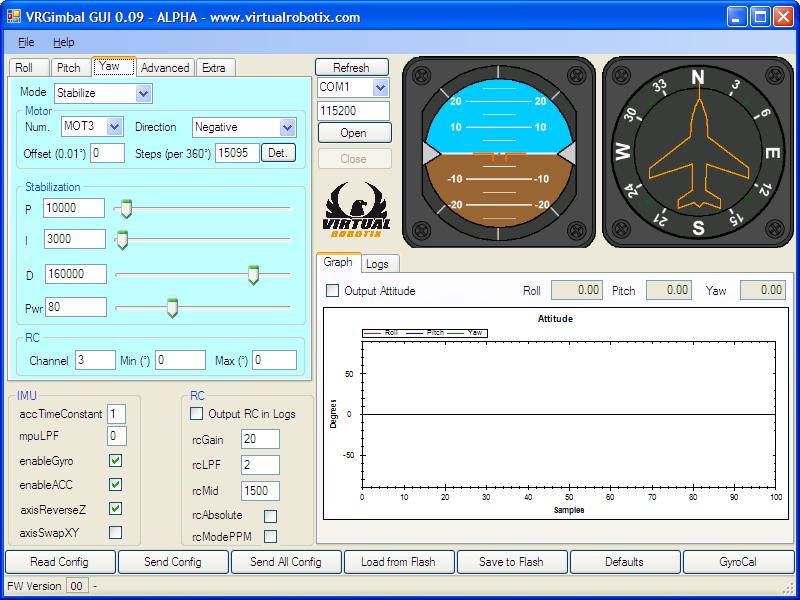Dear Friends,
I'm very happy to present the result of latest VirtualRobotix's development: the new VRX GPS NEO-M8 .
I'ts the first Virtualrobotix's Multi Constellation GPS (GPS, GLONASS, Galileo, QZSS and SBAS), engine, using Ublox NEO-M8 receiver.
The NEO-M8 is a 72-channel high sensitive engine that boasts a Time-To-First-Fix (TTFF) of less than 1 second.
The dedicated acquisition engine, with over 2 million correlators, is capable of massive parallel time/frequency space searches, enabling it to find satellites instantly.
Innovative design and technology suppresses interference sources and mitigates multipath effects, giving NEO-M8 GPS receivers excellent navigation performance even in the most challenging environments.
VRX GPS NEO-M8 is equipped with a Panasonic Amplifier for better reception and a backup battery for quicker warm restarts.
The VRX GPS NEO-M8 also integrates Honywell's latest high precision digital mag (HMC5983).
The HMC5983 can be used either in SPI or in I2C (selectable via a solder Jumper), it has a 200Hz output rate and it's temperature compensated, giving the best experience for our vehicles.
The VRX GPS NEO-M8 is fully compatible with APM:Copter's firmware and it's plug and play on VRBRAIN5, VRuBRAIN5, APM 2.5+, PixHawk and all boards that mount the DF13 connectors.
If you don't have a DF13, you can easly solder standard servo pins on the exposed pads.
The preorder is available at:
VRX GPS NEO-M8: http://www.virtualrobotix.it/index.php/en/shop/accessories/gps-ublox-8-detail
VR uBrain 5: http://www.virtualrobotix.it/index.php/en/shop/autopilot/vrbrainmicro51-detail
If you are interested in the product click on notify me on the website to reserve the product.
Reservation is not binding.
The VRX GPS NEO-M8 has been tested in the field with our VRX300 "Personal Fly Robot SDK Platform" here are some photos and graphs from latest flights.
Flight Controller: VR Micro BRAIN
GPS: VRX GPS NEO-M8
Compass: HMC5983 mounted on GPS board
ESC: 12 A Kiss ESC
Motors: RCX - ZMR
Propellers: APC 6x4
Lipo: 2200 mAh
Radio: Taranis with SBUS receiver X8R
These are the vibration graphs on the VRX300
The number of satellites during this flight started at 11 and arrived to 15, the hdop was from 1.3 to 1.5.
During my tests we have seen up to 18 satellites with an hdop of 0.7 .
With standard GPS module some times it is possible to see only 5 with an high HDOP
Here is possible to see the Altitude from Baro vs Altitude from GPS is not so bad :)
Some RTL and Loiter tests in the Field with precision of less than 1 meter.
Features and Specifications:
- ublox NEO-8 module
- Concurrent reception of GPS/QZSS, GLONASS, BeiDou
- Industry leading –167 dBm navigation sensitivity
- 3,3V or 5V Inputs, with low noise 3.3V regulator.
- 5 Hz update rate
- Rechargeable 3V lithium backup battery for high efficient warm start
- Panasonic Low Noise Amplifier for antenna signal with high gain (19dB)
- EPCOS SAW high quality low-loss RF filter for GPS application
- 25 x 25 x 4 mm ceramic patch antenna
- Dedicated I2C EEPROM for receiver configuration storage
- High resolution compass (2 milli-gauss) and high speed (2 milli-gauss)
- Power and fix indicator LEDs
- ArduPilot Mega compatible 6-pin JST connector
- Exposed pads for simple soldering connection
- 38 x 38 x 8.5 mm total size, 19 grams.
- Receiver type NEO 8
- 72-channel u-blox M8 engine
- GPS/QZSS L1 C/A, GLONASS L10F
- BeiDou B1
- SBAS L1 C/A: WAAS, EGNOS, MSAS
- Navigation update rate:
- Single GNSS up to 18 Hz
- Concurrent GNSS up to 10 Hz
- Position accuracy: 2.0 m CEP
- Acquisition (NEO-M8Q/N)
- (Default mode, GPS/SBAS/QZSS+GLONASS with TCXO)
- Cold starts: 26 s
- Aided starts: 2 s
- Reacquisition: 1.5 s
- Sensitivity
- (Default mode, GPS/SBAS/QZSS+GLONASS with TCXO)
- Tracking & Nav: –167 dBm
- Cold starts: –148 dBm
- Hot starts: –156 dBm
- Connector : Serial Bus , I2C Bus and SPI as option plug and play fully compatible with : VR Brain , APM 2.x , PX4 and Pixhawk Flight Control . Available also solder pad for OEM Application .
Best
Roberto




